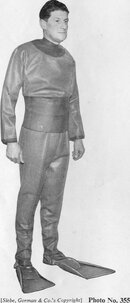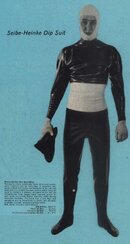David Wilson
Contributor
The Skooba-totes suit, on which the Hydroglove is based, began as a simple two-piece, waist-entry suit in 1958 but acquired a line of accessories over the decade or so it remained in production. One of these accessories was a waist ring and rail, illustrated in the image of the Skooba-totes flyer in my previous message. The caption there reads:
Some divers insist on this hard rubber rail and stretchy ring for sealing pants and shirt on waist entry suit. Rail has stainless spring steel prong.
My mid-1960s Submarine Products catalogue features a green version of the Skooba-totes, imported from the US to the UK, offering as an accessory a "Rubber tube waist seal":
Super stretch rubber tube held with a wooden dowel. Can easily be altered to fit any waist size.
So far as I am aware, the Skooba-totes never came with a waist band, or cummerbund, like the Hydroglove, but cummerbunds were certainly a feature of the British-made Siebe-Gorman frogman suits of the mid-1950s and the Siebe-Heinke Dip Suit of the early 1960s.



So all the seal improvement methods suggested by Hydroglove are historically authentic responses to the problem of leaky waist seals back then.
Some divers insist on this hard rubber rail and stretchy ring for sealing pants and shirt on waist entry suit. Rail has stainless spring steel prong.
My mid-1960s Submarine Products catalogue features a green version of the Skooba-totes, imported from the US to the UK, offering as an accessory a "Rubber tube waist seal":
Super stretch rubber tube held with a wooden dowel. Can easily be altered to fit any waist size.
So far as I am aware, the Skooba-totes never came with a waist band, or cummerbund, like the Hydroglove, but cummerbunds were certainly a feature of the British-made Siebe-Gorman frogman suits of the mid-1950s and the Siebe-Heinke Dip Suit of the early 1960s.



So all the seal improvement methods suggested by Hydroglove are historically authentic responses to the problem of leaky waist seals back then.
Last edited:




